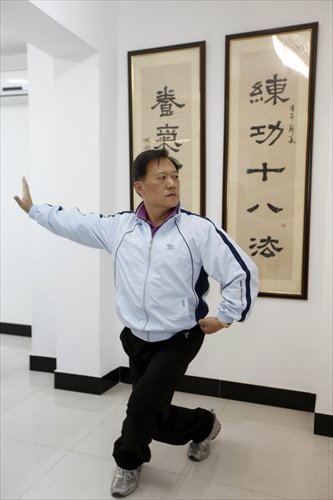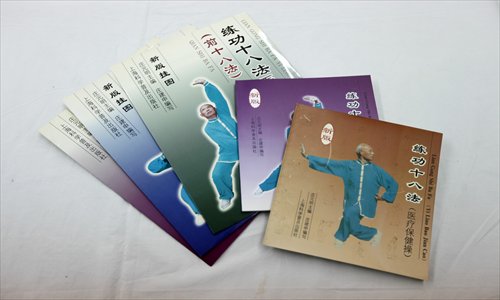Daily kung fu
Editor's Note
According to UNESCO's definition, an "intangible cultural heritage" includes traditions or living expressions inherited from our ancestors and passed on to our descendants, such as oral traditions, performing arts, social practices, rituals, festive events, knowledge and practices concerning nature and the universe or the knowledge and skills to produce traditional crafts. It has to be traditional, contemporary and living at the same time, inclusive, representative, and community-based. The safeguarding of intangible cultural heritage is an important factor in maintaining cultural diversity in the face of growing globalization. An understanding of the intangible cultural heritage of different communities helps with intercultural dialogue, and encourages mutual respect for other ways of life.
The Shanghai Municipal Government has designated 157 traditions as Shanghai's intangible cultural heritages.
The Global Times Metro Shanghai culture page will introduce one intangible culture heritage and interview their current inheritors every month.
In every park every morning, you can see people jogging, dancing and practicing tai chi. It is very likely that you have also passed by people doing liangong shiba fa but have not realized what it is. To put it simply, it's a set of 18 body movements that stretch and strengthen the muscles and joints, popular with local citizens for the last three decades and even listed as one of Shanghai's Intangible Cultural Heritages.

Zhuang Jianshen performs liangong shiba fa. Photos: Cai Xianmin/GT
Every school of kung fu has a long story behind it. This story goes back to 1921, when master Wang Ziping was taking refuge in Shanghai from the Japanese after he had defeated a Japanese judo master in an open ring fight in Qingdao, Shandong Province. Wang, being a famous fighter, was invited to take part in another ring fight held by American, British and German fighters trying to humiliate the Chinese. Once again, Wang won.
Like many martial arts masters at the time, such as Wong Fei-hung, who was immortalized in the Once Upon a Time in China movies starring Jet Li, Wang was also a traditional Chinese medicine doctor specializing in shangke, roughly corresponding to orthopaedics in Western medicine. Wang had many students of martial arts but only one inherited medical skills from him. His name was Zhuang Yuanming and he went on to invent liangong shiba fa, literally "18 ways of exercising."
"After the founding of the People's Republic of China, the government gave Wang many titles, the vice president of the Chinese Association of Martial Arts and so on. He was always very busy and so put my father in charge of his clinic," Zhuang Jianshen, the president of the Shanghai Association of Liangong Shiba Fa and Zhuang Yuanming's son, said.
"During the Cultural Revolution, all private clinics were closed and my father was sent to work in a small hospital in Pudong. Yet patients still came to him. He had to take care of 500 people every day and accounted for 60 to 70 percent of total revenue," Zhuang said. "His massage skills were developed from master Wang and hailed as carving on the muscles."

A series of books Zhuang Yuanming and Zhuang Jianshen compiled to illustrate liangong shiba fa
Before long Zhuang Yuanming found a common problem with his patients; they suffered from chronic pain in the neck, shoulder, waist and legs. He decided to invent a set of exercises based on the massage he gave so patients could heal themselves at home by practicing these movements on a daily basis.
"Traditional Chinese doctors have different views from their Western peers. They prefer massage over surgery and think, for example, when fixing a broken leg, keeping patients still is not enough. One has to make certain movements to prevent the veins and muscles from becoming stiff," Zhuang explained.
In 1977, the elder Zhuang's invention of "Liangong and Massage" was awarded a prize from the government of Shanghai for being a "major breakthrough in science and technology." Doctors from the city's major hospitals, and later from all over the nation, were organized to attend lectures by Zhuang to learn his method.
"It was scientific and was validated by science. According to electromyography (EMG), conducted by the only machine that could do such work in Shanghai back then, liangong alone was more effective than massage or the combination of liangong and massage," Zhuang said. So the set of movements was renamed liangong shiba fa and was made one of the three physical regimens - the other two being tai chi and mass calisthenics - which workers performed in factories nationwide. Zhuang Yuanming passed away earlier this year at the ripe old age of 95.
Liangong looks simple but actually the 18 body movements involve quite complicated breathing control. "It should be done in a slow yet continuous way and when you do it, you do it with strength," Zhuang said. "People who have a martial arts background can tell that these movements can be used for fighting, which I usually don't teach. The true spirit of martial arts is not fighting but friendship," he added.
"You may wonder what the difference between liangong shiba fa and yoga is. While yoga is about stretching beyond your original limits, and thus is more dangerous in a sense, liangong only requires you keep doing the best you can," Zhuang told the Global Times. "The funny thing is, as I have visited India many times and met some true yoga masters, all of them are old men rather than the sexy young women you see in advertisements. I think Indian people would enjoy liangong a lot."
According to Zhuang, liangong shiba fa has become even more popular in countries like Japan, Indonesia and Brazil than it is at home. "Of course in Shanghai there are many people who want to learn and they have to wait in line. I can only teach about 45 people in one class," Zhuang, who teaches for free, said. "In Brazil, for example, it is popularized by insurance companies since it can effectively prevent certain ailments among workers, so bosses also like it since healthier workers improve efficiency." Liangong shiba fa has spread to more than 40 countries and regular international meetings are held every two years.
"I think it can be more useful to Chinese people, especially when seeing a doctor is so costly nowadays," Zhuang said. "I need further support from the government so I can carry out my plans, to digitalize my huge amounts of files and papers which I preserve carefully and completely, and to train more talents outside the Zhuang family, so they can teach a wider range of people."